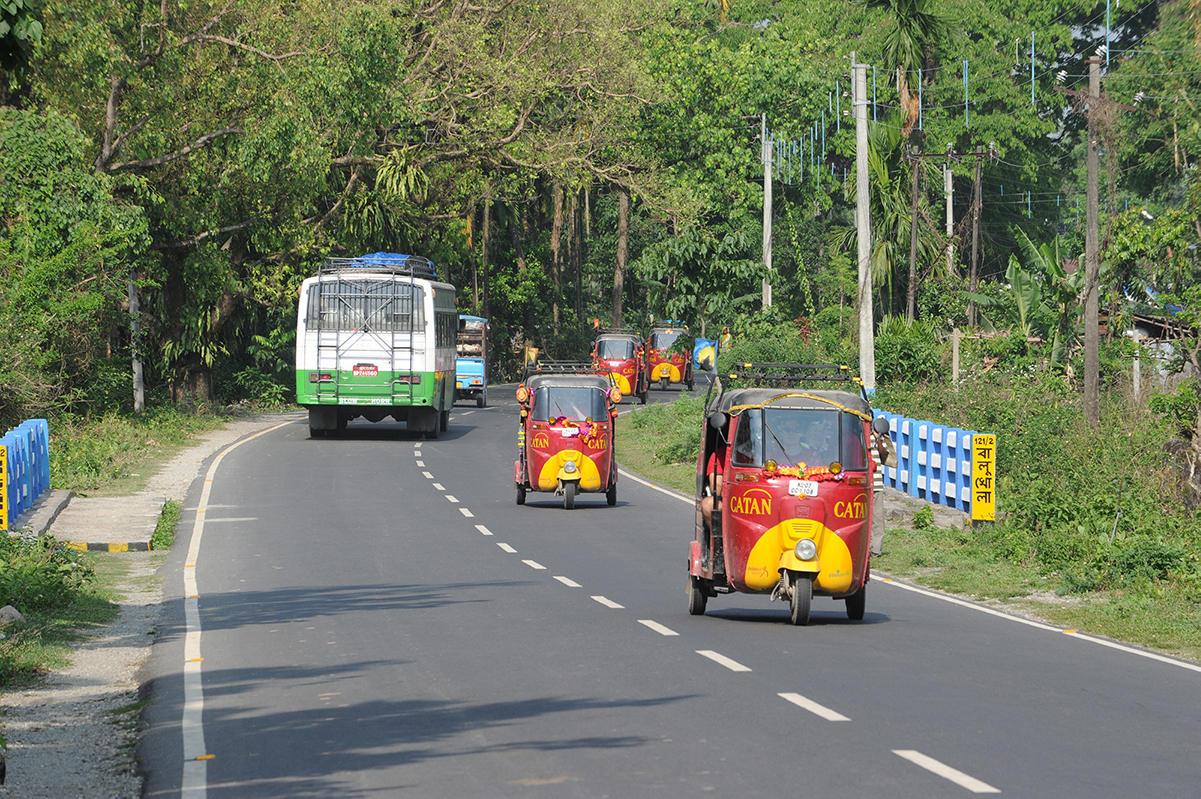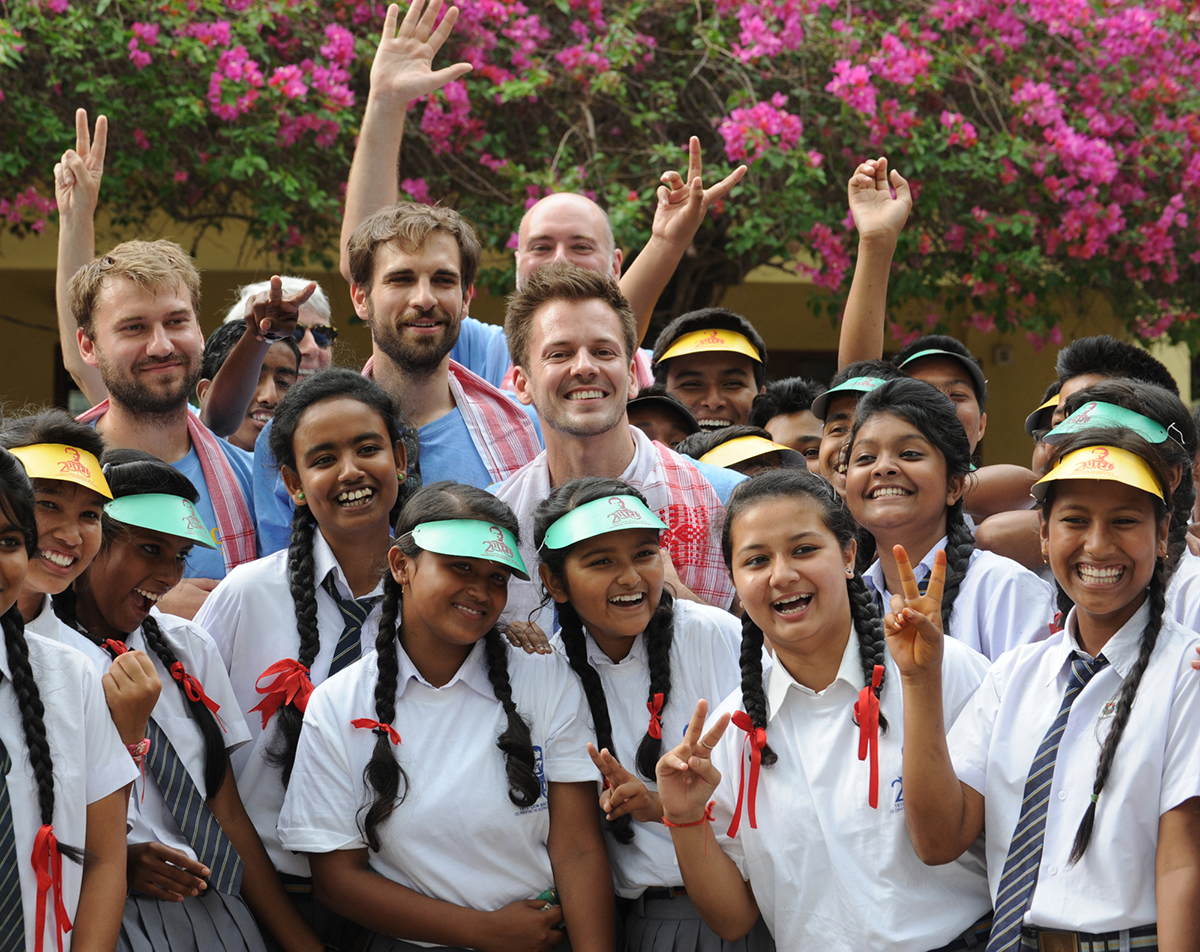Rain fell as Team Catan awoke in their comfortable quarters at the DBI. Mario took a run in the downpour. Martin took Benny, Christian, and Charly to the train station to witness the plight of local homeless kids. Katja and Pete missed the early departure when we got lost in DBI’s maze-like stairwells and passages. We got a long-overdue chance to get to know one another. Since it would be Team Catan's last road day with rickshaws, it was a timely chat.
Once everyone got back, we ate, repacked, and donned orange t-shirts. Then came time for us to go down to our rickshaws. The rain abated in time for our departure. There, the students gathered for photos, autographs, more speeches and a big farewell. Benny placed a pair of fluffy Catan dice around Johnson’s shoulders. Pete did the same with Martin. As the red, white, and blue rickshaws set off with a motorcycle escort through the streets of Guwahati, the rain picked up again. Bihu over and a market day beginning, Guwahati was awash with traffic. Our trio of rickshaws followed the motorbikes toward center city, where we turned into a narrow gateway tunnel that led to the courtyard of Guwahati’s huge, multi-balcony Don Bosco High School. Some 2600 kids awaited us, yelling and waving from each of the school’s four levels. Team Catan drove in circles around the wide, paved courtyard to great applause.
After we ascended the stage and sat like visiting royalty, young girls approached us and, one-by-one, placed yet another traditional red and white Assamese scarf around each crew member's neck. Festivities ensued with band and song performances. Here, we heard our first choir. It was another show of beauty, talent, love, and pageantry. Once again overwhelmed with thanks and joy, we waved and bid goodbye. Team Catan exited via the tunnel, picked up some motorcycle guides, and drove southward through the city. Our escort waved and broke away at the city’s edge.
We now ascended into the hills south of Guwahati. The road wound up, down, and further up again as we left Assam and entered the highland state of Meghalaya. Here, the roughly 2000 meter ascent would test our rickshaws more than ever. The way up required good pacing and longer, more frequent engine rests.
Olivia and Pete had the easiest challenge, for the white rickshaw carried but two passengers. Our gearing was more forgiving and Pete could jump to fourth for much longer stretches. The grade affected each driver and rickshaw differently, making it hard to stay in order and keep regular spacing. We’d drive 50 km before we got the rhythm down.
In the meantime, we encountered 8-10 of our fellow rickshawers. Our only gas stop brought reunions and plenty of road tale exchanges. We could all feel that the finish line was but a few rests away. As we left the petrol station in a phalanx, a road party began. The weaving dance inspired photos, videos, and handshakes for most of the up and down drive toward Shillong.
In time, the road split and we found ourselves in the incredibly scenic highland lake country that gives Shillong its nickname as the “Scotland of the East.” We even stopped at a scenic overlook, where Team Catan’s women all chatted with a trio of young guys rooted in local lore and Hindu history. One was from Nagaland and confirmed the power and preeminence of that state’s legendary pepper.
Shillong covered the hilltops some 100 km south of Guwahati. It had been a favorite British colonial retreat. Now it was a boomtown. The mix of tourism and coal mining created an odd juxtaposition of haves and have-nots. Poverty stood out starkly in its crowded, winding streets and stifling back alleys.
We of course arrived on market day. Since the locals had skipped recent market days, the influx of people and vehicles was especially choking. Team Catan inched up the lanes, often in our rarely-used first gear. The plan was to find the Hotel Barbareek, rendezvous with Ron and Cathy, check in, drop gear, clean up, and then proceed to the finish line. Given the hotel’s tight and obscure alley location by a stinking, rotting, vegetable dump, we spent a lot of time parking and shuttling gear.
Ron and Cathy were nowhere to be seen, nor was the orange rickshaw. Part of the mystery was immediately solved when two guys from the local Don Bosco school arrived to collect the hauling fee for transporting the rickshaw up from Kokrahjar via Guwahati. We paid them and instructed them to haul the rickshaw down to the finish line at the polo stadium. They claimed that they could also transport Cathy and Ron, who were purportedly at the school. (In fact, our two compadres were asleep elsewhere in the hotel!)
The long, drizzly drive from the hotel to the finish line took us through one of the great traffic jams in world history. The congestion, coupled with the fact that no one could locate the hidden finish line, created a slapstick adventure. Other lost rickshaws joined us. It took us an hour to negotiate a couple of km and find our appointed goal in a parking lot adjoining the stadium. We drove up to the finish line with three rickshaws around 5:00 pm.
Rather than crossing the elevated line, though, we elected to park and await the arrival of Cathy, Ron, and their orange rickshaw. Team Catan began turning in their documents and filling out forms just to get a jump on closure. Before we were finished with bureaucratic niceties and darkness began to fall, the DBI truck bearing the orange rickshaw showed. Matt and the Adventurists crew assisted us in gathering about a dozen rickshawers and lifting our rickshaw right off the truck’s flat bed.
No sooner had we gotten the orange rickshaw down, then Cathy and Ron arrived. They told us that we had missed them at the hotel!
Given the fact that their rickshaw was wounded, we gave Cathy the honor of crossing the finish first. She and Ron drove over the dais in triumph. Olivia and Pete followed. Then came Katja, Arnd, and Christian. Charly, Mario, and Benny served cleanup. Team Catan was done! We had driven our four rickshaws over 3000 km in support of the Childaid Network and introduced our brand to India in a novel, positive way. It was time to celebrate!
As we piled onto the buses to head off to the Adventurists’ big Rickshaw Party, Mario and Benny got off to help Charly find her purse. The rest of us missed the memo. Later we would discover that Charly’s purse had been stolen. All of her credit cards, money, and camera stuff were gone. Priceless images had disappeared with the theft and Charly faced a rough police investigation, followed by a difficult 3-day exit out of India. Apparently, one of the roving sports fans existing the stadium had nicked her purse. She was rightfully crushed.
Nonetheless, Charly, Mario, and Benny joined us the party, where there was music, awards, dancing, food, and a bar. Sadly, our beer vouchers only entitled us to lukewarm Buds. Happily, the local rockabilly band really knew their licks. All of us very festive rickshawers had a blast. Matt hosted a hilarious awards ceremony highlighted by the funny tale of our fellow rickshawers blundering into our parade and ceremony in Boko. Cathy won a flagon award for surviving her driving accident and gave a great speech. Charly won a photo award. All of us laughed, drank, and (to varying degrees) danced. It was a fitting celebration.
Team Catan hugged and toasted our collective victory as early as the finish line. So, as the party wore on, we felt comfortable enough to leave in two groups. Charly, Ron, and Cathy stayed through last call. All of us ultimately returned to the Hotel Barbareek in the dark rain and had to make big noise in order for the hoteliers to come down and let us in. Besieged by a dirty, tough neighborhood and lacking any doorbell, the hotel challenged us with one last obstacle before we could all find our triumphant resting place. It was oddly fitting, for everything about the Rickshaw Run was infused with adventure.
Nothing came easy. But hard victory brought sweet joy.

















